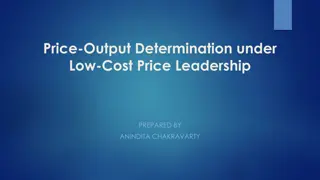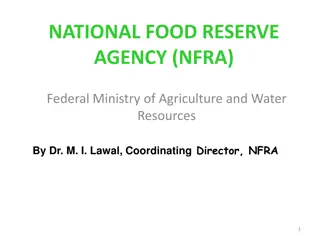Understanding Agricultural Commodities Price Volatility and Food Security
Explore the long-term lessons on agricultural commodities price volatility and food security from a session by Amar Bhattacharya at the G-20 Conference. The content delves into differential impacts of agricultural price developments, coping with short-term volatility, and the imperative to revitalize agriculture. It discusses historical trends, variation in nominal commodity prices, reasons for differential impacts, and the distinction between net-exporters and net-importers across various product categories.
Download Presentation

Please find below an Image/Link to download the presentation.
The content on the website is provided AS IS for your information and personal use only. It may not be sold, licensed, or shared on other websites without obtaining consent from the author. Download presentation by click this link. If you encounter any issues during the download, it is possible that the publisher has removed the file from their server.
E N D
Presentation Transcript
Session IV: Agricultural commodities price volatility and food security Long-Term Lessons from Short-term Volatility Amar Bhattacharya G24 Secretariat G-20 Conference on Commodity Price Volatility, Istanbul, 12-13 September 2011
Outline 1. Differential Impacts of agricultural price developments 2. Addressing and coping with short-term volatility 3. Long-term imperative to revitalize agriculture
1. Differential Impacts of Agricultural Price Developments
Long Term Nominal and Real Agricultural Prices Long Term Nominal Agricultural Prices, Annual Price Indices 2000=100 350 300 250 200 150 100 50 0 1960 1962 1964 1966 1968 1970 1972 1974 1976 1978 1980 1982 1984 1986 1988 1990 1992 1994 1996 1998 2000 2002 2004 2006 2008 2010 Agriculture Beverages Food Raw Materials Long Term Real Agricultural Prices, Annual Price Indices 2000=100 600 500 400 300 200 100 0 1960 1962 1964 1966 1968 1970 1972 1974 1976 1978 1980 1982 1984 1986 1988 1990 1992 1994 1996 1998 2000 2002 2004 2006 2008 2010 Agriculture Beverages Food Raw Materials Source: World Bank, PINK data.
Variation in Nominal Commodity Prices Across Product Groups Nominal commodity prices Base 100=2000 Raw Metals & Minerals Energy Agriculturals Beverages Food Materials Average values 1960-1969 1970-1979 1980-1989 1990-1999 2000-2009 2010 5.00 34.28 90.35 66.75 172.65 271.17 50.50 101.15 124.93 126.38 144.29 231.33 55.98 151.69 183.88 136.52 143.28 253.76 52.55 106.00 124.54 126.57 148.77 224.11 42.74 63.68 95.89 120.75 133.90 237.48 42.30 68.55 98.87 106.92 186.67 337.19 Historical peak 341.97 2008 231.33 2010 322.28 1977 247.41 2008 237.48 2010 339.13 2007 Historical minimum 4.56 1969 48.12 1962 50.16 1965 47.23 1960 37.65 1971 33.35 1962 Source: World Bank, PINK data.
Why Differential Impact? Differences in endowments and production patterns Differences in consumption patterns Impact of domestic policies
Net-Exporters and Net-Importers Across Selected Product Categories Product Category Income grouping Number of Net-Exporters Number of Net-Importers High-income countries Middle-income countries Low-income countries 16 39 15 32 56 24 Agricultural All food items High-income countries Middle-income countries Low-income countries 14 38 10 34 59 30 Basic food (excl. beverages) High-income countries Middle-income countries Low-income countries 14 32 2 34 65 38 Agricultural raw materials High-income countries Middle-income countries Low-income countries 16 35 28 32 61 12 Beverage Crops High-income countries Middle-income countries Low-income countries 15 24 5 33 70 35 Note: The sample consists of 48 high-income countries, 97 middle-income countries and 40 low-income countries 7
Figure 1: Largest Net Exporters and Net Importers: All Agriculture (in US$ Billion) HICs 60 40 20 0 Norway Italy Sweden Hungary Kuwait Malta Latvia Qatar Ireland Poland Japan Croatia Spain Finland Cyprus Oman Canada Iceland Bahrain Austria Germany Barbados Slovenia Switzerland New Zealand Israel Portugal France Greece Greenland Estonia Singapore Australia Bahamas United States Belgium Bermuda Slovakia Netherlands Saudi Arabia Czech Republic Denmark Luxembourg United Kingdom China, Hong Kong SAR Trinidad and Tobago Korea, Republic of Brunei Darussalam United Arab Emirates -20 -40 -60 -80
Figure 1: Largest Net Exporters and Net Importers: All Agriculture (in US$ Billion) MICs 60 50 40 30 20 10 0 C te d'Ivoire Egypt Uruguay Iraq Sudan India Chile Paraguay Brazil Ghana Peru Congo Lebanon Yemen China Angola Turkey Georgia Belarus Algeria Senegal Lesotho Serbia Botswana Azerbaijan Thailand Malaysia Albania Argentina Viet Nam Jordan Ecuador Montenegro Tunisia Nigeria Mexico Ukraine Namibia Mauritius Romania Guatemala Honduras Philippines Morocco Pakistan Jamaica Armenia Colombia El Salvador Papua New Guinea South Africa Costa Rica Libyan Arab Jamahiriya Russian Federation Bosnia and Herzegovina Dominican Republic Iran (Islamic Republic of) Bolivia (Plurinational State of) Venezuela (Bolivarian Republic of) -10 -20 -30 -40 -50
Figure 1: Largest Net Exporters and Net Importers: All Agriculture (in US$ Billion) LICs 3 2 1 0 Mali Togo Guinea Benin Niger Nepal Haiti Malawi Chad Cuba Kenya Uganda Gambia Eritrea Somalia Zimbabwe Myanmar Burundi Liberia Ethiopia Bangladesh Cambodia Tajikistan Mozambique Afghanistan Sierra Leone Madagascar Comoros Kyrgyzstan Burkina Faso Guinea-Bissau TFYR of Macedonia Marshall Islands Central African Republic Dem. Rep. of the Congo Korea, Dem. People's Rep. of Micronesia (Federated States of) -1 -2 -3 -4 -5
All Agricultural Exports: HICs US$ billion 11
All Agricultural Exports: MICs US$ billion 12
All Agricultural Exports: LICs US$ billion 13
2. Addressing and Coping with Short- Term Volatility
Agreement on Some Steps 1. 2. Establish Agricultural Market Information System (AMIS) Improve information and transparency in futures and OTC derivatives markets Improve risk management tools Emergency food reserves for humanitarian assistance with free access Rebuild stocks but costly Targeted social safety nets with focus on nutrition Countercyclical financing from IMF and MDBs Improved interntional coordination 3. 4. 5. 6. 7. 8.
Less on Others 1. Limits on positions or other direct regulations in futures markets 2. International buffer stocks 3. Change biofuels policy 4. Divert grain from biofuels or feed during spikes
2. Long-Term Imperative to Revitalize Agriculture
Hunger World Hungry 30% ~1B hungry, most in Africa and Asia 1 20% Billion Unlikely to meet MDG 1 10% 8% Hunger 2010 1970 1985 2000 2015 Rest of the World Physical, economic & social access to food Africa Non-food system causes Asia & Pacific Hidden hunger (~1B) Over-nourished (~1B) Source: FAO (2010)
Population projection (Lutz & Samir 2010) 95% Increasing demand 12B 60% 20% Population most likely to peak ~9B 8B 4B Livestock consumption (FAO 2009) Livestock consumption 2000 2050 2100 Developed nations China People will be richer and demand higher quality diet India Africa 1970 1980 1990 2000
Current Agricultural Production System Not Sustainable Degradation 24 percent of agricultural land degraded Depletion of forests and over-exploitation of fisheries 70 percent of global water use Nitrogen and other pollutants 30 percent of GHG emissions come directly or indirectly from agriculture Growing constraints on land, water, energy and marine resources
Impact of and Adapting to Climate Change Even with 2 degree mean rise in temperature impact on agricultural output could be 20-30 percent in South Asia and Africa Significant probability of greater increase with unknown impacts Will require large physical and technological investments
A Big Push to Revitalize and Reform Agriculture Significant scope for increasing yields on basis of existing technologies Scope and need for adopting best practices including with respect to sustainable farming Invest in new technology including in adaptive technologies and in capacity building through coordinated global effort (CGIAR, FAO)
A Big Push to Revitalize and Reform Agriculture Large scale private and SOE investments can raise production and productivity of agriculture especially in low income countries But need for transparency and compliance with good practices. Principles for Responsible Agriculture Investments. Main challenge is to revamp public investment at the global, regional and national levels targeted to smallholder agriculture learning lessons from the past.
A Big Push to Revitalize and Reform Agriculture Globally coherent biofuels policies Reach agreement on a development oriented outcome of the Doha Round. Centerpiece must be the abandonment of trade distorting domestic support, reduction of export subsidies and improved market access by advanced economies. Case for transitory safeguards and support especially in low income countries although increases in prices will reduce the need for such protection Domestic regulatory reform Curb Waste
Incremental Financing Needs Are Large ($ billion) Agriculture/ Food Security MDGs + Infrastructure Climate Low Income 50-100 50-100 100-150 100-150 Emerging Markets 200-300 150-200 700-800 200-400 Source: G24 Secretariat estimates 25























